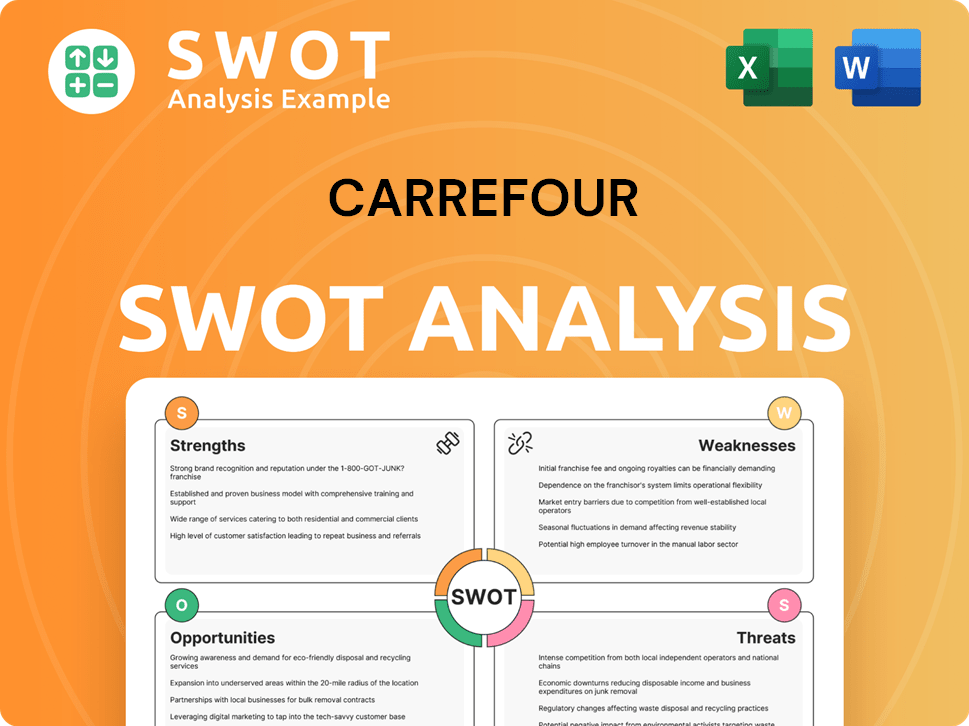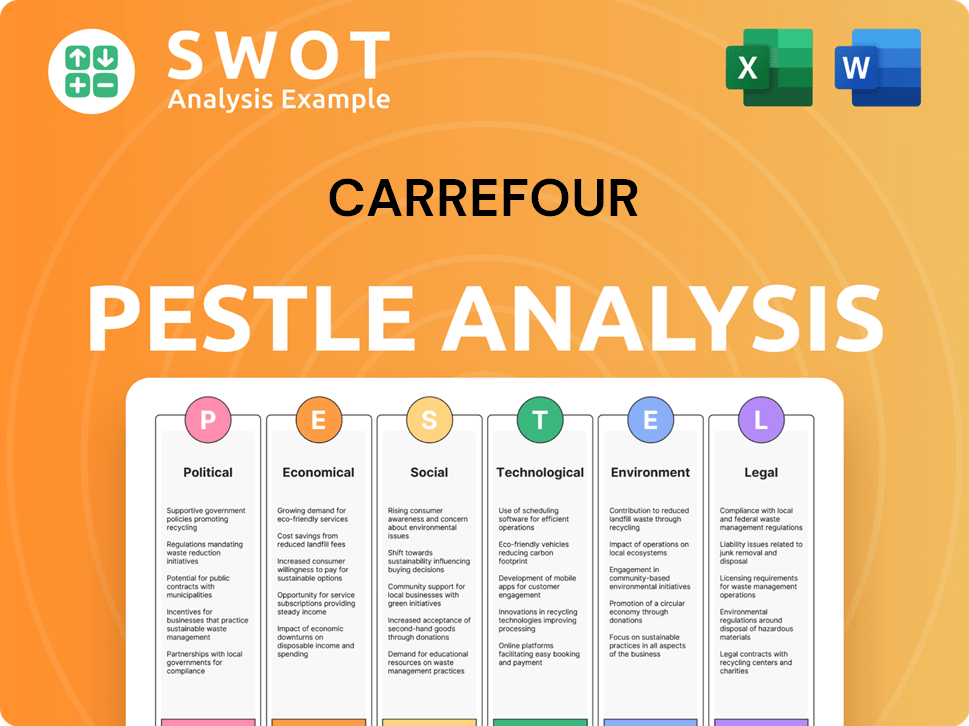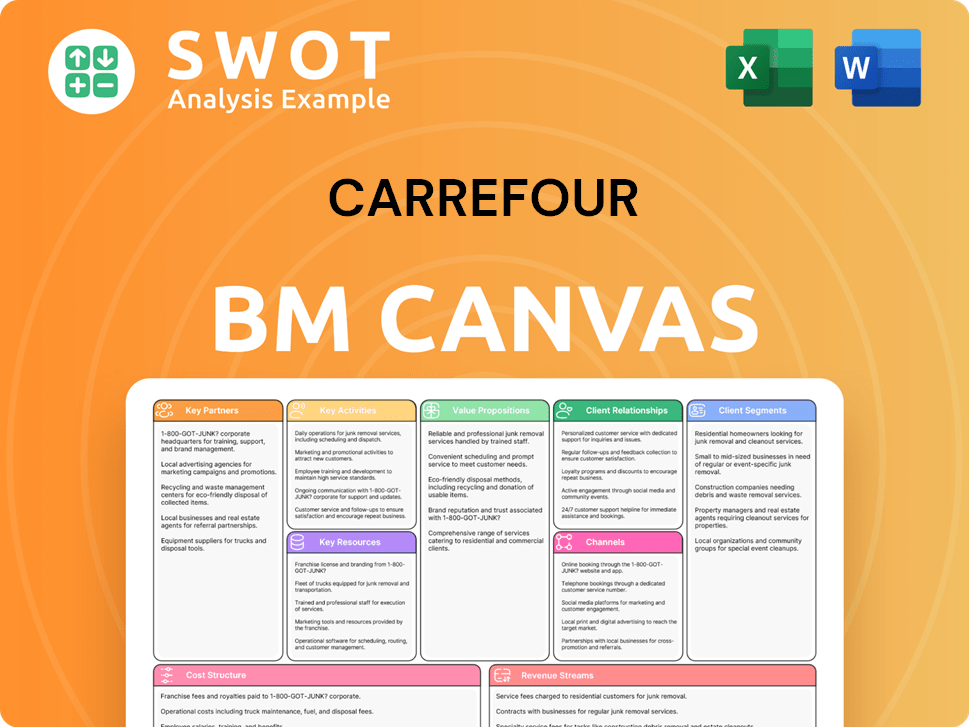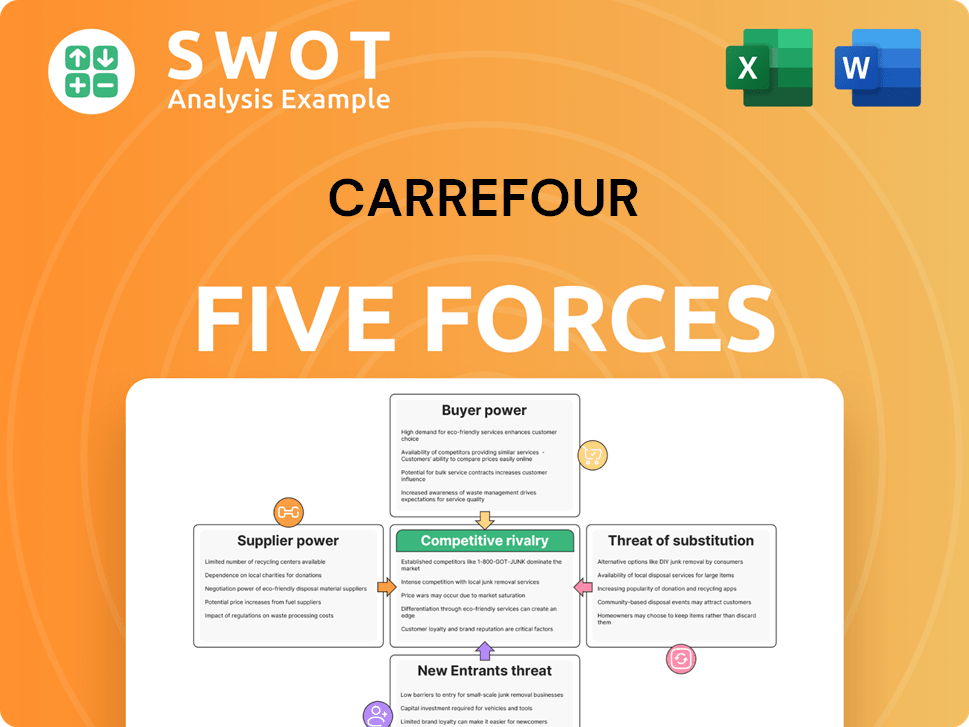Carrefour Bundle
How did Carrefour reshape the global retail landscape?
Carrefour, a name synonymous with modern retail, pioneered the hypermarket concept, forever changing how we shop. Founded in France in 1959, Carrefour's Carrefour SWOT Analysis reveals the strategies that propelled it from a single store to a global powerhouse. This journey showcases remarkable adaptability and strategic vision in a competitive market.

From its Carrefour origins in France, the company quickly expanded, becoming a multinational retailer with a vast network of stores. Understanding the Carrefour history is crucial for investors and business strategists alike. This brief history of Carrefour supermarket will explore its key milestones, expansion history, and its current status in the global market.
What is the Carrefour Founding Story?
The story of the Carrefour company begins on June 3, 1959. The founders, Marcel Fournier, Denis Defforey, and Jacques Defforey, saw an opportunity to revolutionize the retail sector. Their vision was to create a new format that provided convenience and value to customers.
The founders focused on a self-service approach, offering a wide variety of products in one location. This was a significant departure from the fragmented retail environment of post-war France. The first store opened in Annecy, France.
The name 'Carrefour,' which translates to 'crossroads,' was chosen to reflect the store's location and its goal of becoming a central hub for consumers. The founders' expertise in retail and distribution was crucial in the early stages of the company. Understanding the Competitors Landscape of Carrefour is also key to understanding its history.
Carrefour's origins lie in the vision of Marcel Fournier, Denis Defforey, and Jacques Defforey. They aimed to create a retail model that offered both convenience and value.
- The first store opened in Annecy, France, in 1960.
- The name 'Carrefour' was chosen for its symbolic meaning as a 'crossroads.'
- Initial funding likely came from the founders' existing businesses and personal investments.
- The founders' experience in textile and food distribution was instrumental.
Carrefour SWOT Analysis
- Complete SWOT Breakdown
- Fully Customizable
- Editable in Excel & Word
- Professional Formatting
- Investor-Ready Format

What Drove the Early Growth of Carrefour?
The early growth of the Carrefour company was defined by its innovative hypermarket concept. The first hypermarket opened on June 15, 1963, in Sainte-Geneviève-des-Bois, France. This format, which combined a supermarket and department store, quickly became a market differentiator, offering a wide range of products at competitive prices. This strategic move set the stage for the company’s future expansion.
Following the success of its initial hypermarket, Carrefour rapidly expanded its presence within France throughout the 1960s. This focused growth solidified its position in the domestic market. The company's early success was driven by the novelty and convenience of its hypermarket model, attracting a growing customer base.
In the 1970s, Carrefour began its international expansion, entering new markets such as Spain and Brazil. This marked a significant strategic shift, recognizing the potential of its model beyond France. By adapting its business model to suit different cultural and economic environments, Carrefour was able to establish a global footprint.
As of 2024, Carrefour operates in over 40 countries, demonstrating its extensive global reach. The company's revenue in 2023 reached 94.1 billion euros, showcasing its substantial financial growth. This growth reflects the company's ability to adapt and thrive in diverse markets.
Leadership transitions and strategic decisions, such as focusing on organic growth alongside targeted acquisitions, played a crucial role in shaping Carrefour's trajectory. The market reception was largely positive, as consumers embraced the convenience and value offered by the hypermarket model, even with competitors emerging.
Carrefour PESTLE Analysis
- Covers All 6 PESTLE Categories
- No Research Needed – Save Hours of Work
- Built by Experts, Trusted by Consultants
- Instant Download, Ready to Use
- 100% Editable, Fully Customizable

What are the key Milestones in Carrefour history?
The Carrefour history is marked by significant milestones that have shaped its evolution into a global retail giant. From its Carrefour origins in France to its expansive global presence, the company has consistently adapted to changing market dynamics. Understanding the Carrefour timeline is key to appreciating its enduring impact on the retail industry.
| Year | Milestone |
|---|---|
| 1959 | The first Carrefour store opened in Annecy, France, marking the company's inception. |
| 1963 | Carrefour pioneered the hypermarket concept, opening its first hypermarket in Sainte-Geneviève-des-Bois, near Paris. |
| 1970s | The company expanded internationally, establishing a presence in several European countries and beyond. |
| 1999 | Carrefour merged with Promodès, creating one of the world's largest retail groups. |
| 2022 | Carrefour announced its "Carrefour 2026" strategic plan, focusing on digital transformation and expansion in key markets. |
Carrefour has consistently embraced innovation to stay ahead in the competitive retail landscape. The introduction of the hypermarket format was a game-changer, offering a vast selection of products under one roof. Furthermore, the company was an early adopter of technologies like barcode scanning, enhancing operational efficiency. For more insights into Carrefour's business model, you can read about Revenue Streams & Business Model of Carrefour.
Carrefour's introduction of the hypermarket concept in 1963 revolutionized retail by offering a wide range of products in a single store.
The company developed 'free products' in the 1970s, which were early examples of private label brands, providing consumers with more affordable options.
Early adoption of barcode scanning technology improved checkout efficiency and inventory management.
Ongoing investments in e-commerce and digital platforms to enhance online presence and customer experience.
Development of new convenience store formats to cater to changing consumer preferences for quick and easy shopping experiences.
Expanding the offerings of organic products to meet the growing consumer demand for healthier and sustainable choices.
Carrefour has faced numerous challenges throughout its history, including intense competition and economic downturns. The rise of e-commerce has significantly impacted traditional retail models, requiring Carrefour to adapt and invest in its digital capabilities. The company has also had to navigate internal restructuring efforts to streamline operations and improve profitability.
Economic fluctuations have impacted consumer spending and required strategic adjustments to maintain sales and profitability.
Intense competition from discounters has put pressure on pricing and margins, necessitating strategies to differentiate and offer value.
The growth of online retail has forced Carrefour to invest heavily in its digital transformation and online presence to stay competitive.
Shifts in consumer preferences, such as demand for organic products and convenience, have required Carrefour to adapt its offerings and formats.
Restructuring efforts have been undertaken to streamline operations, improve efficiency, and enhance profitability in response to market pressures.
Disruptions in the supply chain, including those related to global events, have presented challenges in maintaining product availability and managing costs.
Carrefour Business Model Canvas
- Complete 9-Block Business Model Canvas
- Effortlessly Communicate Your Business Strategy
- Investor-Ready BMC Format
- 100% Editable and Customizable
- Clear and Structured Layout

What is the Timeline of Key Events for Carrefour?
The Carrefour company has a rich history, marked by significant milestones. Founded in France, it opened its first hypermarket in 1963, revolutionizing the retail landscape. International expansion began in the 1970s, and a merger with Promodès in 1999 significantly increased its market share. Facing new challenges in the 2000s, it launched a major transformation plan in 2017, accelerating e-commerce during the 2020-2022 period. In 2023, the company reported strong revenue, demonstrating resilience and adaptability.
| Year | Key Event |
|---|---|
| 1959 | Carrefour is founded in France, marking the beginning of its journey. |
| 1963 | The company opens its first hypermarket in Sainte-Geneviève-des-Bois, France. |
| 1970s | Carrefour begins its international expansion, entering markets like Spain and Brazil. |
| 1980s | The company continues its global expansion, entering new European and South American markets. |
| 1999 | Carrefour merges with Promodès, significantly expanding its market share and reach. |
| 2000s | Carrefour faces increasing competition, leading to strategic re-evaluations and adaptations. |
| 2017 | The 'Carrefour 2022' transformation plan is launched to address market challenges and accelerate digital growth. |
| 2020-2022 | The company accelerates e-commerce development and strengthens its omnichannel strategy. |
| 2023 | Carrefour reports a strong financial performance with 94.1 billion euros in revenue. |
| 2024-2025 | The company continues to focus on digital transformation, expansion of convenience formats, and sustainable retail practices. |
Carrefour is heavily investing in digital transformation. This includes enhancing its e-commerce platforms and improving the customer experience through data analytics. The goal is to strengthen its omnichannel model. This allows for seamless integration between physical stores and online services.
Sustainability is a key focus for Carrefour. The company is setting targets to reduce its environmental footprint. It is promoting responsible consumption and sourcing practices. This approach aligns with growing consumer demand for eco-friendly options.
The expansion of convenience stores and smaller formats is a strategic priority. These formats cater to the evolving needs of consumers seeking convenience. This expansion allows Carrefour to increase its market penetration and adapt to changing urban landscapes.
The retail sector is experiencing rapid evolution. There's a strong emphasis on personalization, data analytics, and supply chain efficiency. Carrefour aims to leverage these trends to maintain its competitive edge. The company is focused on customer value and operational efficiency.
Carrefour Porter's Five Forces Analysis
- Covers All 5 Competitive Forces in Detail
- Structured for Consultants, Students, and Founders
- 100% Editable in Microsoft Word & Excel
- Instant Digital Download – Use Immediately
- Compatible with Mac & PC – Fully Unlocked

Related Blogs
- What is Competitive Landscape of Carrefour Company?
- What is Growth Strategy and Future Prospects of Carrefour Company?
- How Does Carrefour Company Work?
- What is Sales and Marketing Strategy of Carrefour Company?
- What is Brief History of Carrefour Company?
- Who Owns Carrefour Company?
- What is Customer Demographics and Target Market of Carrefour Company?
Disclaimer
All information, articles, and product details provided on this website are for general informational and educational purposes only. We do not claim any ownership over, nor do we intend to infringe upon, any trademarks, copyrights, logos, brand names, or other intellectual property mentioned or depicted on this site. Such intellectual property remains the property of its respective owners, and any references here are made solely for identification or informational purposes, without implying any affiliation, endorsement, or partnership.
We make no representations or warranties, express or implied, regarding the accuracy, completeness, or suitability of any content or products presented. Nothing on this website should be construed as legal, tax, investment, financial, medical, or other professional advice. In addition, no part of this site—including articles or product references—constitutes a solicitation, recommendation, endorsement, advertisement, or offer to buy or sell any securities, franchises, or other financial instruments, particularly in jurisdictions where such activity would be unlawful.
All content is of a general nature and may not address the specific circumstances of any individual or entity. It is not a substitute for professional advice or services. Any actions you take based on the information provided here are strictly at your own risk. You accept full responsibility for any decisions or outcomes arising from your use of this website and agree to release us from any liability in connection with your use of, or reliance upon, the content or products found herein.